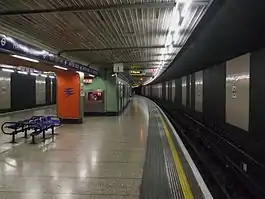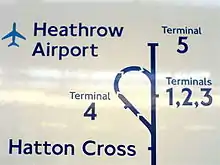Hatton Cross tube station
Hatton Cross is a London Underground station on the Heathrow branch of the Piccadilly line. It is in Travelcard Zones 5 and 6 and stands between the Great South West Road (A30) and the Heathrow Airport Southern Perimeter Road. The station serves a large area including Feltham to the south and Bedfont to the west. The station was named after the crossroads of the Great South West Road and Hatton Road.
| Hatton Cross | |
|---|---|
 | |
 Hatton Cross Location of Hatton Cross in Greater London | |
| Location | Hatton |
| Local authority | London Borough of Hillingdon |
| Managed by | London Underground |
| Number of platforms | 2 |
| Fare zone | 5 and 6 |
| London Underground annual entry and exit | |
| 2015 | |
| 2016 | |
| 2017 | |
| 2018 | |
| 2019 | |
| Railway companies | |
| Original company | London Transport Executive (GLC) |
| Key dates | |
| 19 July 1975 | Station opened as terminus |
| 16 December 1977 | Line extended to Heathrow Central |
| 7 April 1986 | Heathrow Terminal 4 loop opened |
| Other information | |
| External links | |
| WGS84 | 51.46694°N 0.42333°W |
The station, itself in the borough of Hillingdon, serves a very small residential community in Hatton, which is in the borough of Hounslow. The nearby area is partly within the airport but mainly includes its associated commercial warehousing and light industrial premises. "Hatton Cross" refers to the crossroads on the former coaching road leading south west, and is now applied to the overlying major road intersection immediately south east of the station.
Hatton Cross is also the nearest underground station to the popular plane spotting location of Myrtle Avenue, and for this reason is commonly used by plane spotters travelling to the area.[4]
History
The station opened on 19 July 1975 in the first phase of the extension of the Piccadilly line from Hounslow West to Heathrow Airport and it remained the terminus until Heathrow Central opened on 16 December 1977. The extension has been criticised for being built to tube line standards whereas the existing line was capable of accommodating the larger District Line trains.

For the new Terminal 4 at the airport, a single track loop was tunnelled from Hatton Cross to Heathrow Central (now called "Heathrow Terminals 2 & 3") with an intermediate new Terminal 4 station, which opened on 12 April 1986. The tube service to the airport then ran clockwise in a one-way loop from Hatton Cross to Terminal 4, on to Terminals 2 & 3, and back to Hatton Cross.
On 7 January 2005, the loop and Terminal 4 station closed and the tube service reverted to its previous two-way running between Hatton Cross and the Terminals 2 & 3 station while tunnels to the new Heathrow Terminal 5 station were under construction; a shuttle bus from Hatton Cross was provided for passengers travelling to and from Terminal 4. Service round the loop restarted on 17 September 2006.
From 27 March 2008, when the Terminal 5 station opened, alternate trains, of the twelve per hour arriving at Hatton Cross from London, have taken the Terminal 4 loop. These trains call at Heathrow Terminal 4, and then Terminals 2 & 3, before heading back to London. The other alternate trains run direct to Heathrow Terminal 5, via Terminals 2 & 3.
On its opening in 1975, Hatton Cross was one of 279 active stations on the London Underground, the highest ever total; the number of stations in the network has since decreased to 270.
Just to the east of the station the Piccadilly line briefly resurfaces to cross the River Crane then descends back underground again, heading towards Hounslow West.
Immediately to the west of the station is the junction where the Terminal 4 loop diverges; this can be seen from the end of the westbound platform. This junction can be accessed only from the westbound track, thus there is no connection to the eastbound line where trains arrive from Terminals 2 & 3.
Architecture
The platforms at Hatton Cross are in a cut and cover tunnel. The platform tiling on the central columns features patterns derived from the British Airways Speedbird logo. The station building, a brutalist, concrete-and-glass, single-storey box, incorporates a busy bus station, which serves the airport and the surrounding area.
Connections
- The station is a busy tube/bus interchange, at the boundary of the Heathrow free bus zone. To the confusion of some passengers, the station is included in the Heathrow free travel zone for buses, but not for trains from the Underground station. Passengers arriving on trains who have touched in at any of the three Heathrow terminal stations will be charged if they exit the station, in contrast to those only travelling between Heathrow terminals.
- London Buses routes 90, 203, 285, 423, 482, 490, H25, H26 and X26 serve the station.
Incidents
The British Airways Flight 38 accident occurred just west of Hatton Cross in 2008.[5]
References
- "Multi-year station entry-and-exit figures (2007–2017)" (XLSX). London Underground station passenger usage data. Transport for London. January 2018. Retrieved 22 July 2018.
- "Station Usage Data" (CSV). Usage Statistics for London Stations, 2018. Transport for London. 21 August 2019. Retrieved 27 April 2020.
- "Station Usage Data" (XLSX). Usage Statistics for London Stations, 2019. Transport for London. 23 September 2020. Retrieved 9 November 2020.
- "What it's like to go plane spotting next to Heathrow". The Independent. 18 September 2019. Retrieved 27 January 2020.
- Siddique, Haroon (9 February 2010). "British Airways plane crash caused by 'unknown' ice build up". The Guardian. Archived from the original on 12 February 2010.
External links
| Wikimedia Commons has media related to Hatton Cross tube station. |
- "Hatton Cross". Photographic Archive. London Transport Museum. Archived from the original on 26 January 2014.
| Preceding station | Following station | |||
|---|---|---|---|---|
towards Heathrow Terminal 5 | Piccadilly line | towards Cockfosters |
||
Terminus |